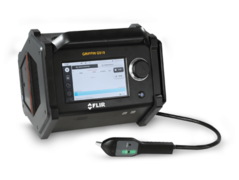Griffin G510
The Griffin 510 is the first easily portable, full-featured GC-MS system (gas chromatograph with mass detector) with an integrated vacuum system and MIMS (Membrane Introduction Mass Spectrometry) interface for direct gas phase analysis. The spectrometer uses a quadrupole analyzer, so the spectra obtained are fully compatible with the NIST library and instant identification of more than 200,000 compounds is possible. All systems available so far had some limitations, in particular the following problems:
- The mass spectrometer is not of the quadrupole type (usually a small ion trap) and produces spectra that are not compatible with the NIST library, the detection capabilities are then limited to a limited range of substances (usually a few tens to hundreds at most). Often the range of m/z analysed or the resolution is also limited.
- The system does not have its own active vacuum system, so a vacuum must be created at an external station and then maintained, usually by means of getters. The equipment is then very expensive to operate and the range of sample introduction options is limited (classical split-split injection is not used, the use of MIMS is problematic).
- These are large and heavy systems (weight 35-80 kg) which are not easily portable and often cannot even operate directly in the contaminated zone.
- Usually very high cost, possibly high operating costs.
All of the above disadvantages are addressed by the Griffin 510 system, and in addition it brings other innovations for use in field analysis.
The instrument uses an LTM (Low Thermal Mass) gas chromatograph, so it is possible to perform very fast and reproducible analyses with minimal power consumption. The gas chromatograph is equipped with both a standard Split/Splitless injection and an integrated thermal sorption/desorption module. The latter can take air samples directly, capture the substances of interest on suitable sorbents and then perform desorption into the gas chromatograph for actual separation and analysis on the mass analyzer. The entire analysis process is fully automated. In cases where the gas phase needs to be measured with a very fast response (reaction times in the order of seconds), the MIMS interface can also be used. Here, the sample is fed to a heated permeable membrane through which the monitored substances pass directly into the mass analyzer. This mode is suitable, for example, for finding sources of leakage in accidents or for continuous air monitoring (protection of VIP areas, monitoring of leakage during technological processes etc.), the analysis speed is 1 second. In the case of direct gas phase analysis, a heated probe is used for sampling, which is an integral part of the Griffin 510. The mass analyzer itself is a quadrupole type with a resolution of 0.7 amu and a range of analyzed effective masses m/z from 15 to 515. The mass analyzer produces standardized spectra fully compatible with the latest generation NIST library (2017 version is integral), EPA and NIH library. The system is equipped with a proprietary vacuum system that uses a combination of a next-generation miniaturized turbomolecular pump and a membrane pump, allowing the instrument to reach full operating state in less than 15 minutes after power-up and requiring no external vacuum sources or expensive sorption cartridges (getters) to operate. For the direct analysis of solid samples or swabs from the surface of objects, the patented PSI Probe technique can be used, which allows the direct introduction of a solid sample into the GC-MS system. For the analysis of organic substances in aqueous media, the SPME or the patented Twister technique can be used, offering significantly improved sensitivity and reproducibility of the analysis. For example, it is possible to quantitatively analyse drug residues in urine directly in the field. At 16 kg, the Griffin 510 is equipped with an integrated high-performance computing system with a 9" high-resolution touchscreen LCD, a 250 GB SSD, Wifi and GPS, standard Ethernet and USB interfaces, an internal He-bomb and battery power (two hot-swappable batteries, so almost continuous operation is possible). The design of the instrument also allows for decontamination of the device and therefore its use in the so-called "hot zone". Great emphasis has been placed on software development, which ensures both easy operation even in the hot zone and a wide range of possibilities in "expert analysis" (including programming of fully automated methods). If an external PC or ruggedized laptop is used, the software from FLIR's large GC-MS/MS systems can also be used, offering all the options known from standard laboratory GC-MS systems.
The Griffin 510 provides a breakthrough in mobile analysis of low concentrations or complex samples. GC-MS technology is considered the "gold standard" in environmental or forensic laboratories, but its widespread use in field analysis has been hampered by the technical limitations of previously available equipment, its high purchase price and often high operating costs. The Griffin 510 provides a solution to all of these problems, opening the way for the widespread application of GC-MS technology in the field, where it can provide reliable results immediately.
-
 Application note - phentanyl detection using GC-MS
size: 1.44 MB
Application note - phentanyl detection using GC-MS
size: 1.44 MB
-
 Brochure G510
size: 960.4 kB
Brochure G510
size: 960.4 kB
© 2025 RMI, s.r.o.
Created by eBRÁNA s.r.o. | Powered by WebArchitect | SEO a internetový marketing


![Unwrap / turn in [-]](/images/arr_down2.gif)
![Unwrap / turn in [+]](/images/arr_right.gif)